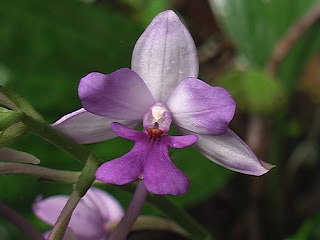 |
| Frost on the grass |
If a solid surface is chilled below the dew point of the surrounding air and the surface itself is colder than freezing, frost will form on the surface.
In general, for frost to form the deposition surface must be colder than the surrounding air.Many plants can be damaged or killed by freezing temperatures or frost. This varies with the type of plant and tissue exposed to low temperatures.
Tender plants like the grass in the picture, die when they are exposed to frost. Cold-hardy plants, such as the plants in the higher elevations can tolerate extended periods of freezing. Eg-
Rhododendron nilgiricum
 |
| Rhododendron nilgiricum in the higher elevation. |
What causes such wide variations in the sensitivity of plants to cold?
As a consequence of natural selection, plants native to a particular hardiness zone are adapted to the temperature extremes that occur in their environment.
In fact, the most widely held explanation of frost damage in plants is that death is caused directly by the advanced state of cellular dehydration that results when ice forms in tissues.
According to this explanation when the concentation of water in cells falls below a critical "threshold" value, protein
molecules in the cells’ protoplasm begin to cross-link with each other, forming a stable but nonfunctional matrix. In this permanently altered state of protoplasm, metabohsm slows to a standstill and, since the cells die, the entire plant dies.
Apparently, species of plants that survive temperatures lethal to other species do so by preventing the dehydration caused by ice formation.
Finally, certain plants are cold tolerant simply because they can recover from even the extreme dehydration
that accompanies ice formation. Examples of such species is Rhododendron nilgiricum.
http://arnoldia.arboretum.harvard.edu/pdf/articles/1198.pdf














